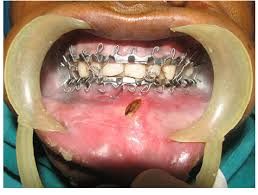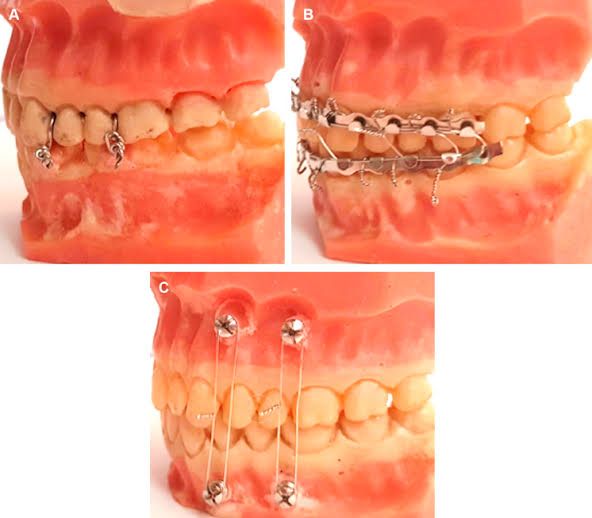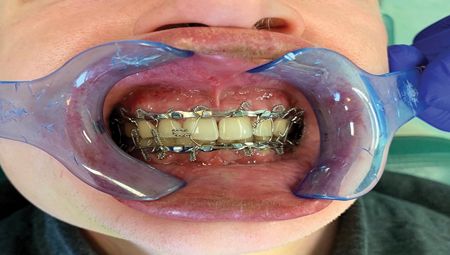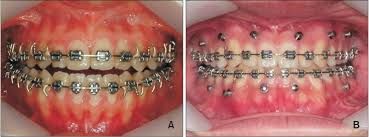Intermaxillary Fixation is a type of jaw wiring commonly abbreviated as IMF. Sometimes it is also called maxillo-mandibular fixation (MMF). It is majorly employed in patients with mandibular fractures or those who are in orthognathic surgery to correct disrupted and deformed jaws which esthetics are required.
Before we proceed, what is jaw wiring itself?
Jaw wiring is a medical procedure undergone to keep the jaw closed for a specified period of time.
In the initial stage, its major purpose was to fix the jaw in place and buy moments for a fracture to get healed. Jaw wiring can also used for weight-loss purposes, which to prevent the ingestion of solid food by keeping the mouth in semi-closed position thereby eventually controlling obesity.
"Jaw wiring is performed by attaching orthodontic brackets to the teeth, and wrapping pliable wire either around or through the brackets or with the use of arch bars or loops affixed with wires around the teeth, or with metal splints bonded to the teeth. The wiring may be configured to immobilise the jaw in the case of fracture or surgery or to place the patient’s lower jaw in a semi-closed resting position. This permits a moderate amount of jaw movement and relatively clear speech, but inhibits the ingestion of solid foods, forcing patients to adhere to a liquid."Source
Now let's discuss on the main aspect of the post which is the intermaxillary fixation technique of surgical procedures;
IMF is a procedure carried out by an oral surgeon, involving the attachment of an "arch bar" to the upper jaw and another to the lower jaw which are maintained with thin wires threaded between and around the teeth.
The arch bars are configured in such a way that they completely enwrap the dental arch. The upper and lower arch bars are related to each other with wires or elastics or screws, which eventually compress the upper teeth against the lower teeth and thus preventing jaw movement.
IMF is an invasive surgical approach performed under general anesthesia. Once the bones have set (usually after 4–6 weeks, sometimes two or three months depending on the intensity of the fracture), the wiring is removed and pull out after the administration of local anesthesia or nitrous oxide sedation so as to numb any accompanying discomfort or pain upon removal of the wires or any materials used for the fixations.
In IMF procedure, there are other methods used for wiring teeth together. Ivy looping is a method by which wires are penetrated between the teeth and gums and then tightened with a loop at the front. Wires are eventually incorporated to these loops.
Cap splints on the other hand, are metal splints which cover the entire surface of the teeth, that is, it is used for dentulous patients.
Fixation can also be achieved as an orthodontic approach by passing wires through the brackets of braces, as commonly used before surgery by some physicians. An orthodontist could assist with such a task.
IMF as aforementioned above can be used to aid weight loss; various studies through decades have employed ivy loops and cap splints to wire the jaws together so as to enforce a liquid diet and prevent solid food until for a period of time for sufficient weight loss to be achieved after some specific months although this approach has been defaulted by some researchers as they claimed patients have been observed to put most of the lost weight back after the removal of fixed wire which has made the jaw to be semi-immobilised and the patients fall back to their old form of life-styles.
Although IMF as a procedure to achieve weight loss can be of significant use if the patient is repeated counseled and a proper follow up and reminder is done by the physician associated with the clinical case of weight loss.
Last but not least as regards the used of IMF for weight control and loss can be of temporary use as some people claimed it is used temporarily by some patients in order to to appear flamboyant in a wedding gown or even jewelleries, to please a lover, or to lower the risk of complications associated with obesity and so on.
Orthodontic Jaw Wiring (OJW) as a method of Transient Jaw Immobilization
This type of jaw wiring is a non-invasive approach requiring no anaesthesia which is employed by a dentist or orthodontist to attach braces to certain teeth (usually the canines and premolars) and inserts wiring, but not elastics, between the upper and lower teeth in a figure-8 structural pattern so as to limit the extent to which the jaws may open.
This approach is also called dental jaw wiring and it is usually used as a temporary treatment for obesity and for gluttons who engage in compulsive overeating.
In this procedure, the wiring is removed at periodic intervals to allow the jaw joints to move freely, especially in the vertical direction and not to provoke the temporomandibular joints due to inadequate occlusion that may accompany its use.
OJW does not permit the upper and lower teeth to be in perfect occlusion as in the resting position of the both jaws, the teeth are parted away by 2–4 millimeters, with the both lips slightly touching each other.
However, the wiring is removed when the patient has achieved their desired weight loss thus making it a temporary treatment for obese patients.
That's all as regards this posts on intermaxillary fixation at least for now. Thanks for the unalloyed support and usual follow-up for the write-up, it is highly appreciated and welcomed.
Happy Blogging and Reading
Video from Dental Pathshala YouTuber




Telegram and Whatsapp